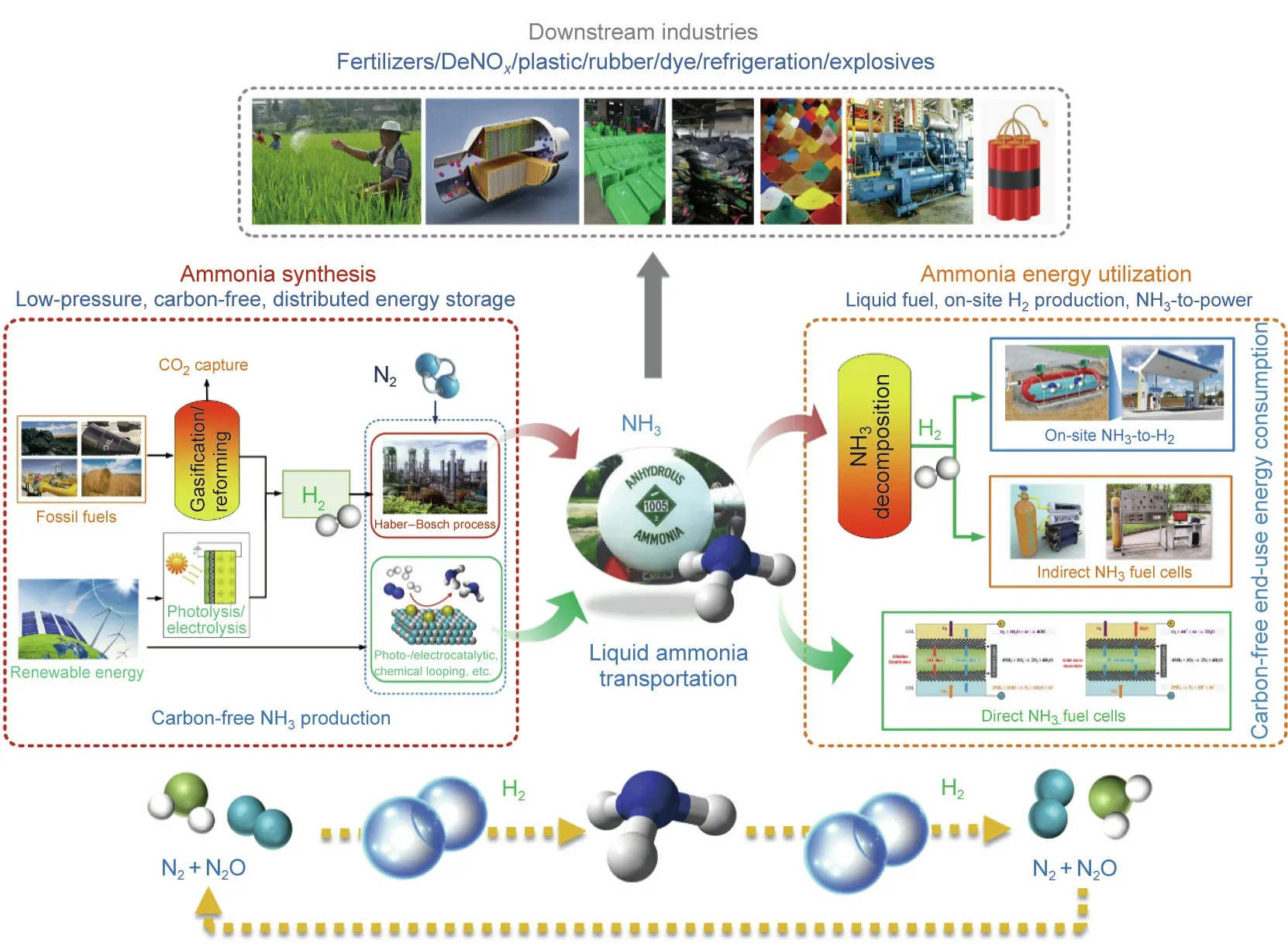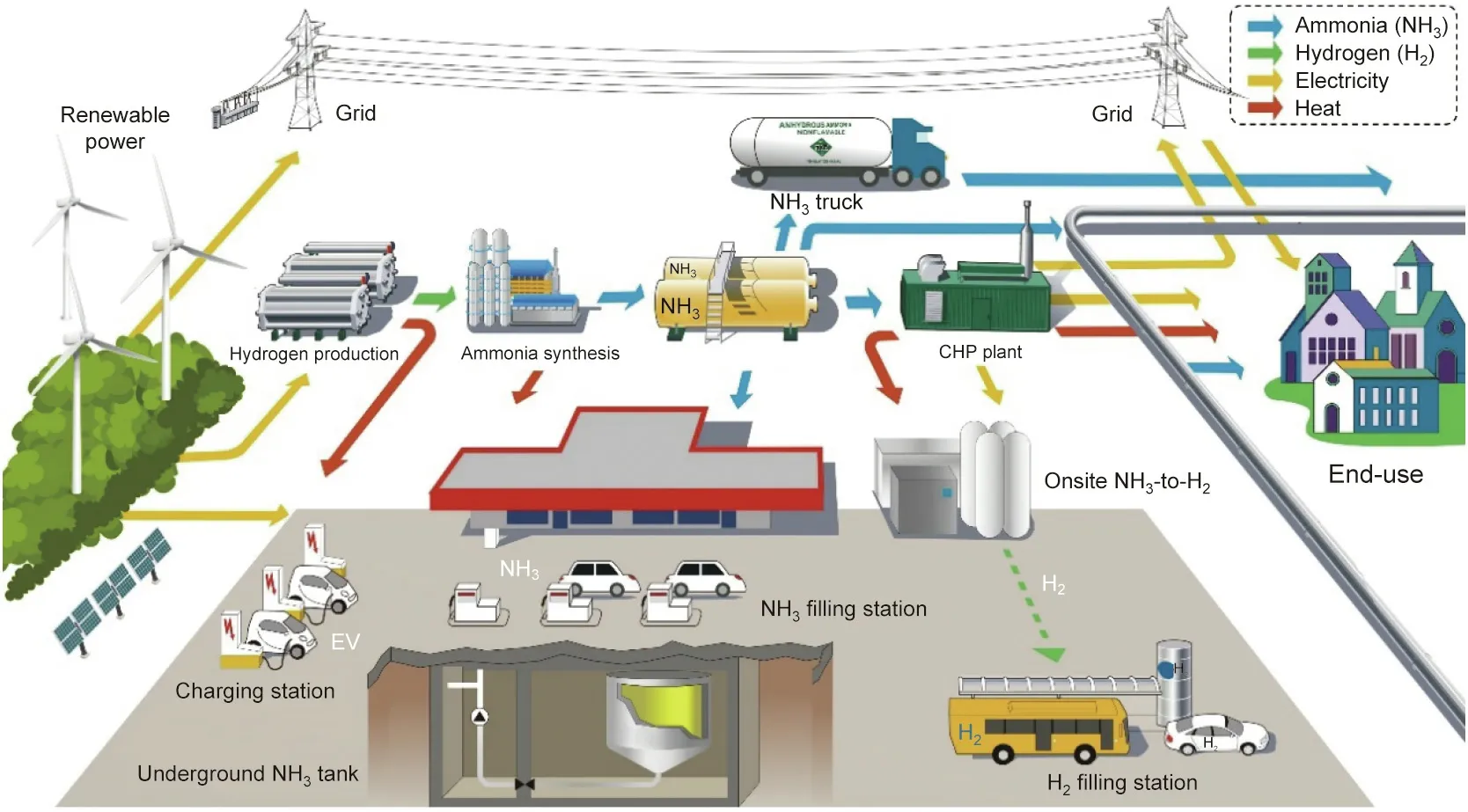An Ammonia–Hydrogen Energy Roadmap for Carbon Neutrality:Opportunity and Challenges in China
Lilong Jing, Xinzhi Fu
a National Engineering Research Center of Chemical Fertilizer Catalyst (NERC-CFC), College of Chemical Engineering, Fuzhou University, Fuzhou 350002, China
b State Key Laboratory of Photocatalysis on Energy and Environment, College of Chemistry, Fuzhou University, Fuzhou 350002, China
1. Opportunities and a bottleneck in the hydrogen energy industry
Hydrogen(H2)is a carbon-free energy carrier with a wide range of application scenarios that was first emphasized in the Report on the Work of the Government in 2019 in China.In March 2021,President Xi Jinping reiterated that China pledges to achieve the goals of peak carbon emissions by 2030 and carbon neutrality by 2060.The Report on the Work of the Government in 2021 highlighted these goals again. In general, the hydrogen energy roadmap is one of the most feasible pathways to realize lower carbon emissions and carbon neutrality. The International Energy Agency(IEA) has predicted that the global demand for green and blue hydrogen will be 75 million tonnes by 2040, according to the Sustainable Development Scenario [1].
For the large-scale application of hydrogen energy, cost-effective and highly efficient fuel cell technology needs to be developed, along with safe and efficient hydrogen storage and transportation. Nevertheless, hydrogen storage and transportation, with their high cost and low intrinsic safety level, comprise the main bottleneck limiting the development of the hydrogen energy industry. Hydrogen has a low volumetric energy density and is commonly pressured at between 35 and 70 MPa for storage and transportation, which results in high cost and unexpected risks. As indicated in the White Paper on China Hydrogen and Fuel Cell Industry, there will be more than 10 000 hydrogen refueling stations in China by 2050 [2].According to the estimated investment cost of 15 million–30 million CNY per station, the total infrastructure investment would be as high as 150 billion–300 billion CNY. In 2019, three hydrogen explosion accidents caused by H2tank leakage were reported in Norway and the Republic of Korea within 20 days,amplifying the public’s concerns regarding the diffusibility,inflammability, explosibility, and intrinsic safety of hydrogen.Consequently, in order to bypass the bottleneck in the hydrogen industry, it is extremely important to develop hydrogen storage and transportation technology that is safe, commercially available, and highly efficient, to match the industry chain and the energy and industry structures in China.
2.Ammonia:A feasible solution to bypass the bottleneck in the hydrogen energy industry
Ammonia (NH3) is a vital chemical feedstock in the national economy and the citizens’livelihood.It is widely used in the fields of agriculture, environmental protection, the military, and refrigeration, among others [2]. Furthermore, NH3is an H-rich energy carrier with the following advantages [3]:
· High energy density. NH3has a volumetric energy density as high as 13.6 MJ·L-1, which means that 1 L of liquid NH3is equivalent to 4.9 L of compressed H2at 35 MPa, or 1200 L H2at 0.1 MPa and 25 °C.
· Low transportation and storage costs. At 25 °C, NH3can be liquefied at 1.0 MPa.A liquid NH3truck has a loading capacity of 30 t NH3(equivalent to ~5.29 t of H2),which is one order of magnitude higher in H capacity than a hydrogen tube trailer(<400 kg H2) [4]. As a result, the transportation cost of NH3(approximately 0.001 CNY·(kg·km)-1) is one order of magnitude lower than that of H2(0.02–0.10 CNY·(kg·km)-1).
· Large-scale carbon-free energy storage.The mature technologies, established standards, and low costs of NH3synthesis,storage, and transportation enable its seasonal, long-distance,and carbon-free energy storage. Power-to-NH3reveals both relatively higher energy efficiency and lower levelized cost than most alternative power-to-liquid technologies (e.g.,liquid H2, liquid CH4, CH3OH, liquid organic hydrogen carriers(LOHC), etc.) [5].
· A high safety level.NH3has a much narrower and safer explosion limit (16%–25%) than H2(4%–76%), and NH3detection is made easy by the pungent odor of NH3.
With these advantages,NH3shows great potential as a promising H2carrier capable of solving the issues related to hydrogen storage and transportation.
NH3synthesis by means of the Haber–Bosch process has a history of over a century. Complete industry chains, industrial standards, and safety specifications for the production, storage,transportation, and utilization of NH3have been well established in China. The carbon emissions from ammonia synthesis will be 0.27 billion tonnes in 2030, based on the output of 50 million tonnes of NH3,80%of which is produced from coal gasification and 20% from methane reforming.
The installed renewable power capacity in China is the largest in the world. However, the intermittency, volatility, and seasonality of renewable power (represented by solar, wind, and hydropower) lead to the large-scale curtailment of wind, photovoltaic(PV), and hydropower resources. As reported by the National Energy Administration of China [6], China’s overall renewable power curtailment exceeded 102.3 TW·h in 2018,mainly in northwest, north, and southwest China. Coupling renewable-powerdriven photocatalytic/electrocatalytic water splitting with NH3synthesis can promote renewable power utilization and peak regulation, achieving low cost, low carbon emissions, long-distance energy transport, and the combination of renewable energy with NH3downstream industries.
As estimated, the use of NH3as an H2carrier has remarkable economic benefits. For example, an onsite hydrogen refueling station using NH3decomposition can reduce the hydrogen cost to less than 35 CNY·kg-1[7].An indirect NH3fuel cell integrating NH3-to-H2and fuel cell technologies can achieve NH3-to-power on the end-user side costing only 1 CNY·(kW·h)-1or 0.25 CNY·km-1. In the case of the direct use of NH3as fuel,station operators can easily transform a petrol station into an NH3refueling station with a low retrofitting cost that is equivalent to the investment cost of a new petrol station, which is one order of magnitude lower than the investment cost of a new H2refueling station.According to China’s target of 10 000 H2refueling stations by 2050, the use of NH3can save as much as 100 billion CNY. Therefore, the use of NH3as an energy carrier can link the renewable energy industry to hydrogen energy and conventional NH3-related industries. The ammonia–hydrogen green energy roadmap (Fig. 1) can be summarized as:clean low-pressure NH3synthesis →safe and economical NH3storage and transportation →carbon-free efficient NH3–H2utilization.
The ammonia–hydrogen roadmap matches well with the characteristics of Chinese energy and is of significance for national energy and environmental security, as well as for sustainable economic and social development.
3.Challenges and suggestions for an ammonia-hydrogen green circular economy
As a potential energy carrier, NH3can solve the challenges of the hydrogen industry,including the high cost of hydrogen storage and transportation, the low energy density by volume of H2, and hydrogen’s low intrinsic safety level. Research on NH3energy has been widely launched, including the Renewable Energy to Fuels Through Utilization of Energy-Dense Liquids (REFUEL) programs by the US Department of Energy (DOE) and the power-to-NH3-to-electricity demonstration projects in Europe and Japan. Developing a clean and high-efficiency NH3energy roadmap can help in achieving energy conservation and emission reduction in NH3synthesis while bridging the gap between the renewable energy industry and the hydrogen energy industry caused by hydrogen storage and transportation. Inspired by the H2Ber project [8], we propose application scenarios of the future ammonia–hydrogen zero-carbon circular economy, as shown in Fig. 2 [9]. The price of renewable power is the main factor affecting the production cost of green NH3. As estimated, the production cost of green NH3would be 1700 CNY·t-1in 2035 and 800 CNY·t-1in 2060. Correspondingly, the NH3-to-power cost would be 1.0 CNY·(kW·h)-1in 2035 and 0.5 CNY·(kW·h)-1in 2060. To achieve this roadmap,our scientific and industrial communities must solve the following technical challenges:

Fig. 1. An ammonia–hydrogen green energy roadmap.

Fig. 2. The ammonia–hydrogen energy zero-carbon circular economy [9]. CHP: combined heat and power; EV: electric vehicle.
· Challenge 1: Developing scalable NH3synthesis catalysts with high-performance functioning at low temperatures and low pressure; low-temperature NH3decomposition catalysts; corresponding catalytic reactors applicable to these novel catalysts;and novel ammonia oxidation reaction(AOR) electrocatalysts and membrane electrode assembly(MEA) with high performance and high stability for direct NH3fuel cells.
· Challenge 2: Achieving the integration,design optimization,dynamic management, and nonlinear control of hybrid systems coupling intermittent renewable energy, H2production, and the NH3synthesis process.
· Challenge 3:Achieving efficient integration,compact design,and intelligent cooperative control of safe low-temperature onsite NH3-to-H2and NH3fuel cell systems.
Based on the current status of the renewable energy industry and hydrogen energy industry in China and technical challenges,we propose the following suggestions for the development of an ammonia–hydrogen circular economy in China.
3.1. National guidance
The government should reexamine the new role of NH3as an energy carrier and/or fuel and promote the development of the hydrogen energy industry by using NH3. On a national scale, the government should lead the formulation and planning of ammonia–hydrogen energy development. More specifically, the government should complete the corresponding laws and regulations,strengthen the construction of an energy supervision system,launch a series of ammonia–hydrogen energy demonstration projects based on local advantages and characteristics across the country,and optimize the energy industry structure.Furthermore,with NH3in mind, the related departments should introduce new universal standards and policies covering equipment specification,certification and accreditation, and security requirements.
3.2. Research and development (R&D) community construction
The related departments should unite domestic preponderant technical forces to construct a multidisciplinary ammonia–hydrogen energy innovative platform.The aim is to integrate the conventional NH3synthesis industry, the renewable energy industry, the hydrogen energy industry,and the related industrial chains.Meanwhile, guided by the government, the involved authorities, industries, universities, and research institutes should cooperate and build a Chinese Ammonia–Hydrogen Green Circular Economy Alliance.
3.3. Key technological development
Designated scientific research teams should focus on the R&D of the key technologies. The teams researching photocatalytic water splitting should put more effort into achieving a breakthrough in wide-absorption-spectrum and high-quantum-efficiency photocatalytic water splitting catalysts and a scalable photocatalytic reactor with high solar energy efficiency. The teams working on NH3synthesis should focus on developing novel low-temperature and low-pressure NH3synthesis catalysts and their large-scale preparation in order to break through the limitations of NH3synthesis in terms of temperature and pressure;meanwhile,they should put effort into the integration, management, and nonlinear control of the systems coupling intermittent renewable energy, water electrolyzers, and NH3synthesis.
Furthermore, cutting-edge investigations on catalytic material design and development of the technique of mild-condition NH3synthesis are needed.The teams focusing on NH3energy utilization should achieve a breakthrough in low-temperature NH3decomposition catalysts and their large-scale preparation, as well as in highly thermal-coupling autothermal NH3decomposition reactors.Moreover,these teams can integrate low-temperature NH3decomposition technology with effective H2–N2separation to develop onsite NH3-fed hydrogen production and refueling systems, or with fuel cell technologies to develop indirect NH3fuel cell systems and their corresponding intelligent control technology. In addition, teams should carry out cutting-edge investigations on direct NH3fuel cells involving electrocatalytic material design of AOR and process development.
Scientific research and engineering teams should unite to realize the demonstration of the following advanced NH3–H2technology chain by 2025:renewable-energy-driven water electrolysis →lowtemperature low-pressure NH3synthesis →onsite hydrogen production from NH3→indirect NH3fuel cells.
At the next stage, the united teams should realize the innovative development of the following transformative technology chain by 2035: photocatalytic/electrocatalytic water splitting →mild-condition NH3synthesis →direct NH3fuel cells.
The ultimate aim is to develop the following green circular economy roadmap with a completely independent intellectual property rights:clean low-pressure NH3synthesis →safe and economical NH3storage and transportation →carbon-free efficient NH3–H2utilization.
Acknowledgments
This work was supported by the Key Program (22038002) and the National Outstanding Youth Foundation (21825801) from the National Natural Science Foundation of China (NSFC), and the Fujian Science and Technology Major Project (2020HZ07009).
- Engineering的其它文章
- The Intelligent Beijing–Zhangjiakou High-Speed Railway
- Mechanisms of Steatosis-Derived Hepatocarcinogenesis: Lessons from HCV Core Gene Transgenic Mice
- Microneedle Makers Seek to Engineer a Better Shot
- Battery Recycling Challenge Looms as Electric Vehicle Business Booms
- Global Top Ten Engineering Achievements 2021
- Biomedical Engineering: Materials, Devices, and Technological Innovation Continue to Build a Better Future for Humankind

